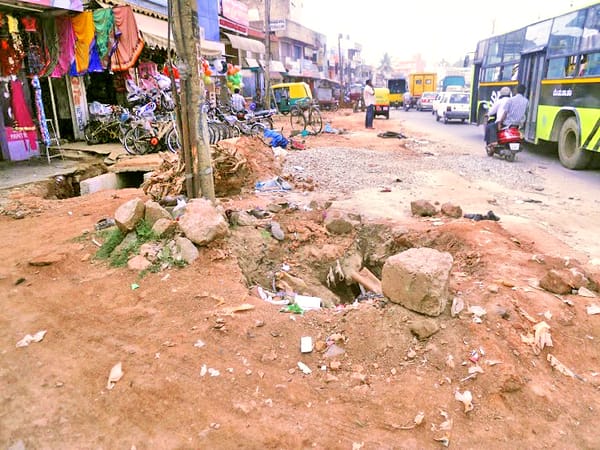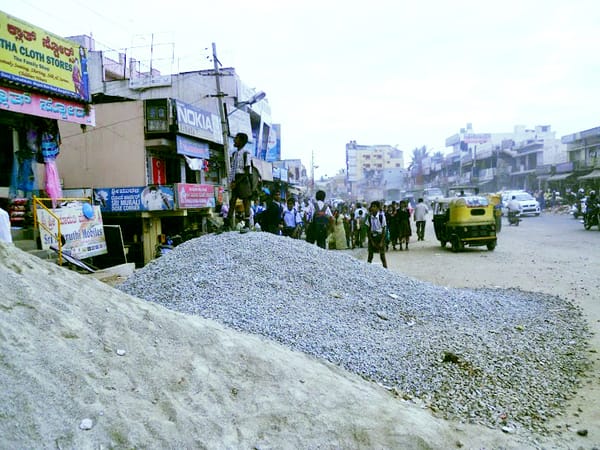The dug footpath with tree trunks at the Sunkadakatte main road leaves no space for pedestrians. Pic: Bosky Khanna
For Bhavya K, a resident of Sunkadakatte, Magadi Road, travelling on a mere 2-km stretch till Sumanahalli flyover takes around 45 minutes. The reason: the road is dug by the civic agencies for widening and laying pipelines. This is not all – the road is also filled with potholes and resembles nothing less than a death trap.
She was even more shocked on Thursday, June 13, 2013, when she saw three big trees cut to the stump and logs piled up next to it. “These were beautiful trees that gave a lot of shade. They were a great support during rainy and sunny days. This is not the first time when the civic agency has been brutal towards greenery. Earlier a huge tree which would have aged over five decades in the same area was axed for road widening. This road widening is a never-ending task here.’’
She is not the only one who is worried about the present condition of the road. Magadi Road is a state highway, but does not resemble one, complains Vaidyanatha T, a shopkeeper. “It is a very busy road and vehicles move here round the clock. But this is no excuse for the delayed work, it should rather be the reason for speeding up works.”
Deepak K, a resident of Sunkadakatte, fractured his leg when he fell on the pothole at night, in the absence of streetlights. He complains that the road has never been maintained by the BBMP. During elections, corporators and politicians come begging for vote and promise to improve the condition, but disappear once the elections are over. The same has repeated this year. The road has never been tarred; with every downpour, the potholes are becoming bigger. Recently some of the workers put all the excavated mud in the potholes- could be a good intention- but after the heavy rainfall on May 31, the whole area became a slush pool. “We do not know where to complain and to whom as no one is ever seen here taking charge,“ complains Deepak.
Mohan Kumar, who runs a grocery shop in Sunkadakatte Market says that the authorities pay no attention to this area as it is a newly added ward away from the city centre. For all government and civic authority officials, Bangalore exists only in central business district and extends to posh localities like Domlur, Whitefield and Bannerghatta Road. “No one ever comes here and talks to us. No one is bothered about the voters residing in this part of the city,” he adds.
Last year, all shopkeepers had even closed their shops for a day, to draw the attention of the officials towards the plight of the area and ensure justice is given to them. But nothing has changed.
School children and other citizens, standing on the piled up debris and construction materials, await BMTC bus at the Sunkadakatte market bus stop. Pic: Bosky Khanna
Problem for commuters
Sunkadakatte market is a busy commercial area. It has commercial establishments of all sorts and also houses two temples. Everyday scores of people visit the market and catch buses to Peenya Industrial area, Magadi village, Mysore road, Tavarekere and T G Halli. Many commuters go by this stretch of the road to connect to NICE Road.
But the road is filled with potholes and speed breakers. It is a two-lane road on the market side which has two bus stops opposite to each other. This creates another bottleneck. The road widens from Vishwadheenam post on one side and near the Outer Ring Road junction (which connects to Bangalore University and Mysore Road) on the other side. The uneven road width is another menace.
During morning and evening hours, the problem is the worst, when students are seen struggling to reach the school on time. Many garment and industry workers are seen making their way to work. The presence of banks, restaurants, government offices and residences has only added to the problem.
No two- wheeler can pass smoothly between two buses, when they are standing at the bus stop. Many private buses stop for long, which, according to commuters, is a menace. Traffic police officials are seen striving for long hours trying to control the traffic. An on-duty traffic police official said that they are battling heavy dust and air pollution, by wearing face masks.
The cop added that, a road barricade has been erected for a short distance which does not serve the purpose, as people do not follow lane discipline. Furthermore, there are two bus stops within a distance of 300 metres.
Road widening work on this chaotic stretch commenced two years ago, while the plan of widening the entire Magadi Road from Binny Mill (behind City Railway station) was mooted around five years ago, said a BBMP official, on condition of anonymity.
What once stood majestically as a big tree was axed down to make way for the widened road. Only stumps remain now. Pic: Bosky Khanna
Pollution, dust cause health problems
Respiratory problems, constant cold and cough, dust allergy, skin infections and irritations and accidents regularly affect the residents, commuters and shop owners in the area.
Dr A Radhakrishnan, a doctor practicing in Sunkadakatte, said that, due to increased dust and vehicular smoke, the number of patients suffering from respiratory problems and various skin allergies have increased. Cold and cough are the common symptoms here. Many patients also come complaining of ear pain as they are constantly exposed to loud horns.
School children and infants are seen to suffer with the same problems. In their case skin infections are maximum. Children get fever constantly, which in long run affects their health, pointed Dr Sangeeta, practicing in the same area.
‘Official’ version of the story
According to the BBMP officials, the work of road widening and upgrading for 5.6kms stretch has been undertaken at a cost of Rs 45 crore. This also includes construction of pedestrian underpass. It starts from NICE road junction and ends at Central Relief Committee (Beggars Colony) which is near Sumanahalli Flyover- this connects to Outer Ring Road. Interestingly the BBMP has now scrapped the idea of constructing the pedestrian underpass at Sunkadakatte market. This, they say, is because of the troubles they faced and are facing while widening the road.
The BBMP official opines that the problematic area lies between Sunkadakatte Market and Beggars Colony, which has 1.3kms of the market area and 900 metres land from the colony. The BBMP is widening the road from the existing width of 5.5 metres X 5.5 metres (one and half lane) to 22 metres.
Till recently, three months ago, members of the Colony and shop owners in the market were reluctant to part with their land. “They cannot be forced as land is being taken under the Transferable Development Rights (TDR) scheme. It took us very long to persuade them and presently 600 metres of this stretch has been completed,” the official explained.
Meanwhile, the BWSSB merged their project of laying underground pipes and sewerage lines with BBMP, because of which the road widening work was brought to a halt. The BBMP completed 2.3kms of road work from NICE Road to Vishwadheenam post.
Now the task of completing the work from Vishwadheenam post till Sumanahalli flyover is pending. The BBMP started digging this stretch only six months ago and will complete it by July 15, said the official.
To compensate for the trees felled, BBMP would create a green road just like in Yelahanka, and Mysore road. A green road, according to BBMP, is a road, which has a tree line avenue on either side of the side and on the median with local native tree species.


